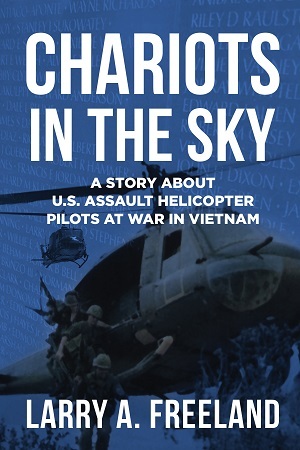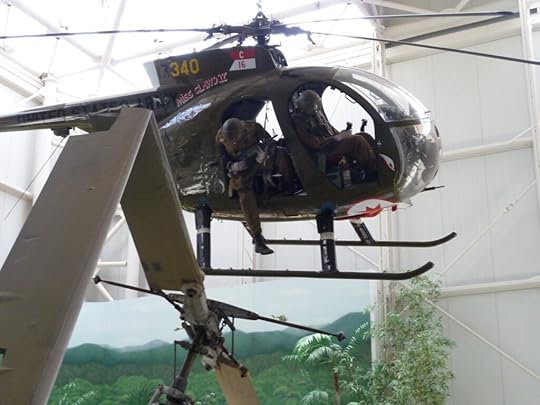New Release Spotlight — CHARIOTS IN THE SKY: A Story about U.S. Assault Helicopter Pilots at War in Vietnam by Larry A. Freeland
 Join Captain Taylor St. James, along with his friends and comrades, as they fly harrowingcombat missions, cover for each other, deal with bad weather, mechanical problems and humanerror during the later part of the Vietnam War. When not flying, they areharassed by rocketattacks and sappers in the wire. Taylor discovers the North Vietnamese are not his only enemy ashe copes with the pressures put on him by a commander more interested in personal glory thanhis men’s well being.
Join Captain Taylor St. James, along with his friends and comrades, as they fly harrowingcombat missions, cover for each other, deal with bad weather, mechanical problems and humanerror during the later part of the Vietnam War. When not flying, they areharassed by rocketattacks and sappers in the wire. Taylor discovers the North Vietnamese are not his only enemy ashe copes with the pressures put on him by a commander more interested in personal glory thanhis men’s well being.
This is the story of Captain Taylor St. James, a dedicated Army helicopter pilot, who is sent toVietnam. He just wants to do his job, survive the war and return home to his wife Sandy andfamily. While performing his duties, Taylor will be challenged and tested beyond any measurehe could have ever envisioned.
He is assigned to the Eagles, a Huey Assault Company with the 101st Airborne Division in ICorps. Taylor’s unit is stationed at Phu Bai Base where they fly missions throughout thenorthern region. Their flying exploits take them into many familiar places to include: A ShauValley, Khe Sanh, Quang Tri Province, Hue, DMZ, North Vietnam and Laos.
Along the way Taylor participated in Lam Son 719, the last major American OffensiveOperation of the war. This historical campaign lasted for sixty days and involved over 750helicopters flying in and out of Laos supporting the South Vietnamese incursion into Laos. LamSon 719 was the costliest period of helicopter warfare for the Americans. More helicopters wereshot down and sustained battle damage than any other period during the Vietnam War.
 Guest Post
Guest PostThings I Didn’t Know About Vietnam
By Larry A Freeland
Before leaving for Vietnam and during my stateside military training I heard many stories about Vietnam. People who had been their or claimed to be knowledgeable of Vietnam and the war would tell me what I could expect, what I should do or not to do when I got in-country, what the Vietnamese people were like, how to fight and deal with the NVA (North Vietnamese Army) communist and Vietcong insurgents in the south. Some expressed the believe that our enemies were invincible and unbeatable, and so on. I guess, like most other veterans who were sent to Vietnam and survived, I have recollections of what I thought I would experience and then the reality of what I lived through.
I was sent to Vietnam on January 3, 1971 and served one year in I Corp. with the 101st Airborne Division as a CH-47 helicopter pilot and Infantry Officer. In this capacity I flew all over the northern portion of South Vietnam from Da Nang to the DMZ, from the coastal lowlands to the mountains of the A Sau Valley and even into Laos for a few months. When not flying I was performing other duties where I was interacting with local Vietnamese military personnel and local civilians in the Phu Bai and Hue. These opportunities provided me with many impressions and observations leading me to form some of my own opinions of the Vietnamese people and their country.
Not surprising, there were many things I wasn’t aware of about Vietnam as a country and its people before I got there. Here is a list of what I encountered and learned while serving in country:
1. The diversity of its people, which varies from well-educated to many living an agrarian lifestyle with little or no formal education.
2. The country’s geography includes tropical lowlands, rolling green hills, densely forested mountains, and coastal lowlands. There were mountains in the northern area, A Sau Valley, that toped 5,000 feet. Much of it was beautiful and some day would make great travel resorts and vacation related places to visit. That has become the case, with some very fine locations, particularly along their coastlines and in and around what was called Saigon and now is Ho Chi Minh City.
3. Weather extremes ranged from hot and humid to cold and damp, but I never saw any snow. I had been in Vietnam for what seemed an eternity and experienced very poor weather and flying conditions many times. However, I wasn’t aware that Vietnam was susceptible to typhoons. About eight months into my tour, we were hit by a typhoon in the 101st Divisions area of operations. It wasn’t a devastating typhoon, but it did considerable damage to our facilities and knocked out power and water supplies for several days. On any given day, power and water supplies could be interrupted, but not for the length of time we experienced with the typhoon.
4. Their religious beliefs can include Catholicism, Buddhism, Hinduism, and Confucianism.
5. Many Vietnamese placed high importance on family and respect for their elders. I found them to be a caring and supportive people when it came to their families and elders, those living and those who were deceased.
6. Their political views were not as simple as we we’re led to believe. Most Vietnamese I met impressed me as people who just wanted to be left alone. They wanted to be free of foreign interference, have their own country, and many just wanted to live as their ancestors had for centuries. Before we got involved with Vietnam, it had been a French colony since 1887. When the French were forced out of Vietnam, we eventually moved in. Over the centuries, Vietnam had endured border conflicts with their northern neighbor China. During our war with them, the Chinese and the Russians allied with the north and hoped to gain favor with the North Vietnamese.
 About the Author
About the Author Larry Freeland was born in Canton, Ohio. Since his father was an officer with the United StatesAir Force he grew up on many Air Force bases across this country. After graduating from HighSchool at Ramey Air Force Base in Puerto Rico, he attended the University of South Florida inTampa, Florida. He graduated in 1968 with a degree in mathematics and a concentration infinance. He joined the U.S. Army and served one tour in Vietnam with the 101st AirborneDivision as an Infantry Officer and a CH–47 helicopter pilot. He is the recipient of theDistinguished Flying Cross with one Oak Leaf Cluster, the Air Medal, with 10 Oak LeafClusters, the Bronze Star, and various other military service medals.
Larry Freeland was born in Canton, Ohio. Since his father was an officer with the United StatesAir Force he grew up on many Air Force bases across this country. After graduating from HighSchool at Ramey Air Force Base in Puerto Rico, he attended the University of South Florida inTampa, Florida. He graduated in 1968 with a degree in mathematics and a concentration infinance. He joined the U.S. Army and served one tour in Vietnam with the 101st AirborneDivision as an Infantry Officer and a CH–47 helicopter pilot. He is the recipient of theDistinguished Flying Cross with one Oak Leaf Cluster, the Air Medal, with 10 Oak LeafClusters, the Bronze Star, and various other military service medals.
Upon release from active duty in 1973, Larry returned to civilian life and pursued a career in theFinancial Industry. During his professional career, he continued his education, earning graduatedegrees in Management and Banking. He worked for 29 years in the banking business withTrust Company of Georgia, Citizen and Southern Corporation, now Bank of America, andWachovia, now Wells Fargo. After retiring from banking he worked as an independent financialconsultant for 3 years in the Atlanta area and then worked as an instructor for 6 years with LanierTechnical College in their Management and Leadership Development Program.
Larry is now retired and lives in North Georgia with his wife Linda, a retired school teacher.They stay involved in various activities, most notably those associated with the Cystic FibrosisFoundation and Veterans related organizations. They also enjoy traveling together and spendingas much time as possible with their two daughters, three grandsons, and two granddaughters.
The post New Release Spotlight — CHARIOTS IN THE SKY: A Story about U.S. Assault Helicopter Pilots at War in Vietnam by Larry A. Freeland appeared first on Quiet Fury Books.



